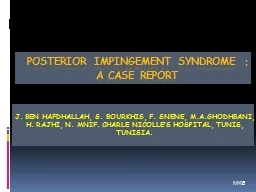PPT- POSTERIOR IMPINGEMENT SYNDROME
Author : test | Published Date : 2017-08-11
A CASE REPORT J BEN HAFDHALLAH S BOURKHIS F SNENE MAGHODHBANI H RAJHI N MNIF CHARLE NICOLLES HOSPITAL TUNIS TUNISIA MK6 OBJECTIVES Evaluate the role of imaging
Presentation Embed Code
Download Presentation
Download Presentation The PPT/PDF document " POSTERIOR IMPINGEMENT SYNDROME " is the property of its rightful owner. Permission is granted to download and print the materials on this website for personal, non-commercial use only, and to display it on your personal computer provided you do not modify the materials and that you retain all copyright notices contained in the materials. By downloading content from our website, you accept the terms of this agreement.
POSTERIOR IMPINGEMENT SYNDROME : Transcript
Download Rules Of Document
" POSTERIOR IMPINGEMENT SYNDROME "The content belongs to its owner. You may download and print it for personal use, without modification, and keep all copyright notices. By downloading, you agree to these terms.
Related Documents














